Kids Web Japan
Web Japan > Kids Web Japan > Meet the Kids > Tokamachi > Classes
Meet the Kids
Tokamachi Elementary
School
Arrival, Classes, and Lunch
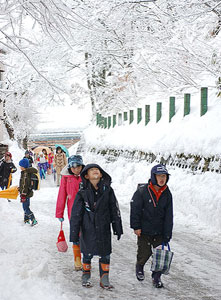
The kids walk to school even when it is snowing.
During the winter the weather in Tokamachi
is harsh, with heavy snowfall and strong winds. The students of Tokamachi Elementary
walk to school dressed in winter coats, hats, and Wellington boots and carrying umbrellas
to shield themselves from the worst of the cold.
"It takes me about
20 or 30 minutes to walk to school. The snow is hard going, but the toughest thing
is when the wind is strong," grumbles a sixth-grade girl. But all the children
are used to the snow and are skilled at walking the snow-covered roads, and by just
after 8:00 a.m. most have arrived at school. Shaking the snow off their coats at the
entrance, the students enter the school, their breath white in the winter air.
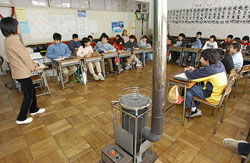
The classrooms are heated by oil heaters. It still feels cold, though!
Tokamachi Elementary is one of the biggest schools in the city of Tokamachi, with two or three classes in each of the six grades. Each class has about 25 to 35 students, who usually gather at 8:25 for homeroom. Every Wednesday morning, however, the whole school gathers in the gymnasium for a weekly assembly. The first lessons get underway at 8:35. Each lesson lasts 45 minutes, and there are four classes in the morning and two after lunch.
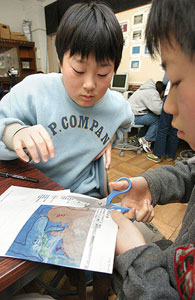
Predicting cloud movements using images from the Himawari weather satellite.
The students settled down in their classrooms, and in the computer room on the second floor the kids of Year 4 Class 2 were sitting at about 20 desktop computers in the middle of a science class. They were learning about the weather - the differences between low and high pressure, how to read a weather map, for example - using images from the Himawari weather satellite.
Ms. Yamamoto, their homeroom teacher, said: "We can see the latest data sent by the Himawari every three hours, so the students make weather forecasts based on the movements of the clouds. So far they have been right with about 85% of their predictions. But it's very hard to predict snow clouds in winter, so they're not having so much luck at the moment!"
The 35 students are divided into nine groups, and each group is composing its own forecast while studying the weather data. As they look at the positions of areas of high and low pressure, there are animated discussions within the groups as to what the data means.
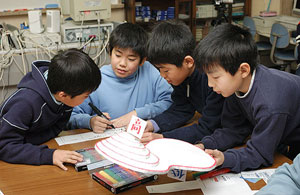
This group is using a model of high and low pressure areas to predict tomorrow's weather.
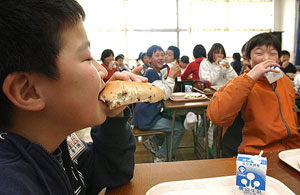
Niigata Prefecture is famous for its delicious rice, but for lunch today the kids are having chocolate-chip bread.
"Today there are two high pressure areas and two low pressure areas, so it's difficult to predict the weather," says Yuki Mizuochi of the second group, who has so far been the most accurate forecaster in the class. His group's forecast says, "There are snow clouds over the Sea of Japan, so it's going to snow during the morning. But there's a region of high pressure right nearby, so the wind will pick up and blow the clouds away, bringing sunshine in the afternoon."
By contrast, the overwhelming view among the other groups is "cloudy, with snow later." (As it turns out, the next day was sunny all day, so Yuki's group had the most accurate prediction.)
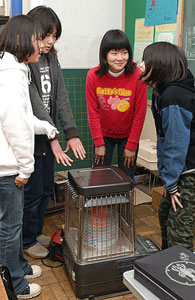
Even kids who are used to the snow get cold sometimes!
It's 12:15. When the fourth class of the day ends, lunch carts loaded with lunches made in the school kitchen deliver the meals to each classroom. As the smell of the hot food spreads, the three students in charge of serving lunch, who are wearing matching white aprons, hats, and face masks, dish out the food to their classmates. Today's lunch consists of clam chowder, cauliflower and broccoli salad, chocolate-chip bread, and dried chestnuts. The lineup changes every day, and some days the kids have a classic Japanese meal of rice, miso soup, and grilled fish.
Some sixth-grade girls comment, "Our favorite is cream stew!" Soup-type dishes seem to be popular in the bitter cold of a Tokamachi winter.